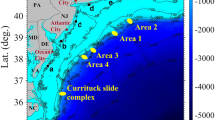Abstract
—A modified and corrected version of the viscous slide model of Jiang and LeBlond (1994) is used to assess the tsunami risk associated with hypothetical underwater slope failures in two coastal areas of British Columbia having potentially unstable sediment deposits: (a) Malaspina Strait, separating the mainland coast and Texada Island in the central Strait of Georgia; and (b) Roberts Bank on the foreslope of the Fraser River Delta in the southern Strait of Georgia. The intent of this study is to demonstrate the capability of the model for tsunami risk assessment and to improve upon previous studies of tsunami risk in the region based on reasonable submarine landslide scenarios. The potential risk from tsunamis associated with slide failures has been examined, but the likelihood of failure events themselves was not considered. For the Malaspina Strait scenarios, simulated tsunamis are generated by failure of a lobe of perched sediment situ ated on the slope of eastern Texada Island. Failure as a flow slide of the estimated 1,250,000 m3 of sediment generates wave troughs reaching −4.9 m and trough-to-crest heights of 6 to 8 m along the coast of Texada Island. At Cape Cockburn, on the opposite side of the strait, wave heights of 1.5 to 2.0 m are produced. For Roberts Bank, simulated waves are examined for two separate failure scenarios. The larger slide (Case 1) involves the failure of a sediment lobe with lateral dimensions of 7 × 3 km2 and volume of 0.75 km3 while the smaller slide (Case 2) fails a sediment lobe with dimensions of 4 × 2.6 km2 and volume of 0.23 km3. Computations were made both for high (+3 m) and low (−3 m) tide conditions. For both failure volumes, maximum wave amplitudes (up to 18 m for Case 1 and 8 m for Case 2) occur on the coasts of Mayne and Galiano Islands, opposite the source area. Wave amplitudes are much smaller (1 to 4 m) on the mainl and coast because of the reflection of the initial waves from Roberts Bank. Additional numerical experiments were conducted for both regions to estimate the sensitivity of the computed tsunami wave heights to input parameters, such as slide viscosity, bulk density, and slide position.
Similar content being viewed by others
Author information
Authors and Affiliations
Additional information
(Received March 7, 2001, accepted October 22, 2001)
Rights and permissions
About this article
Cite this article
Rabinovich, A., Thomson, R., Bornhold, B. et al. Numerical Modelling of Tsunamis Generated by Hypothetical Landslides in the Strait of Georgia, British Columbia. Pure appl. geophys. 160, 1273–1313 (2003). https://doi.org/10.1007/s000240300006
Issue Date:
DOI: https://doi.org/10.1007/s000240300006




